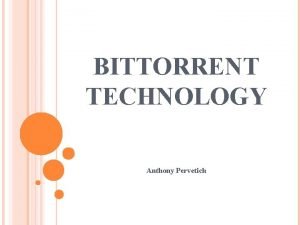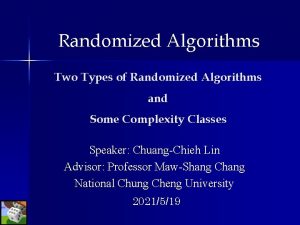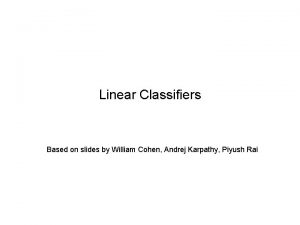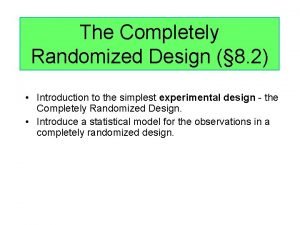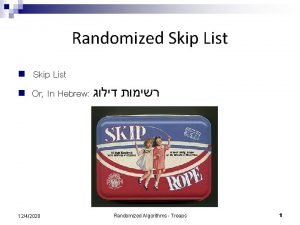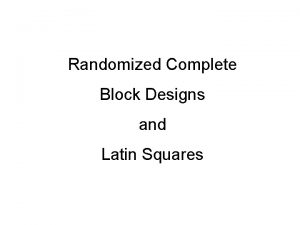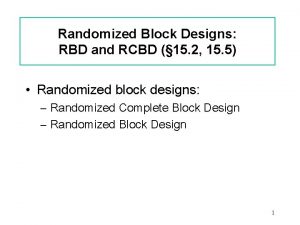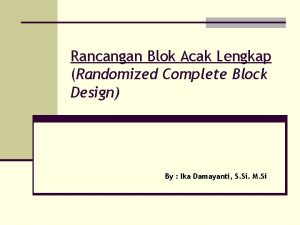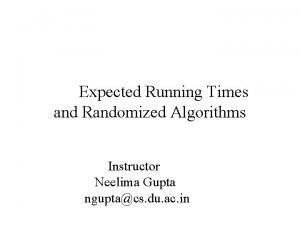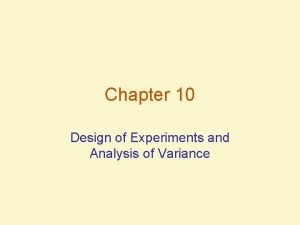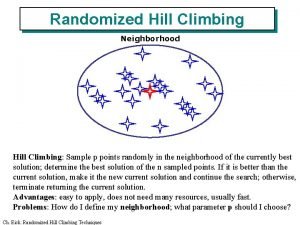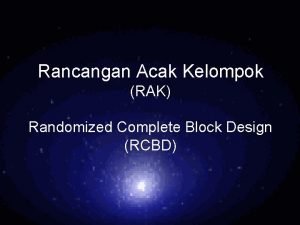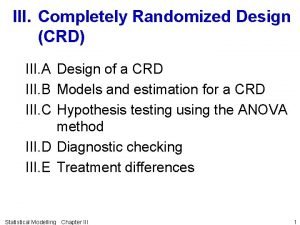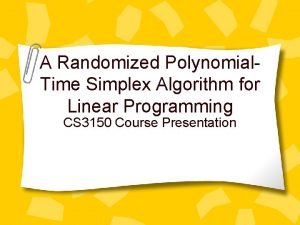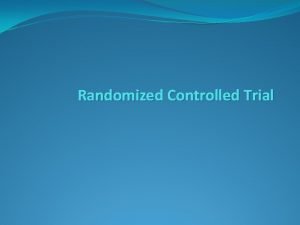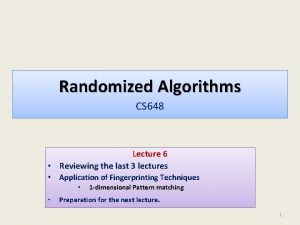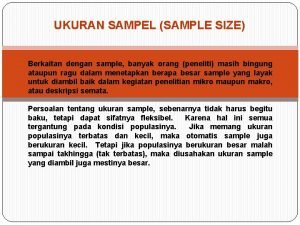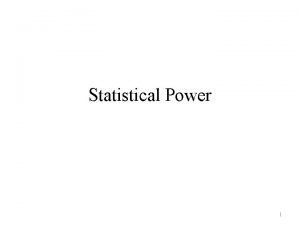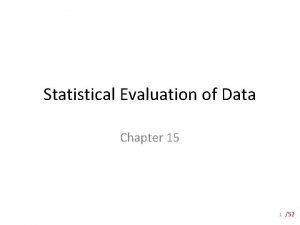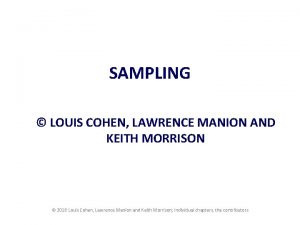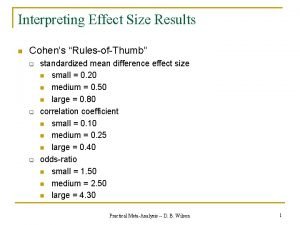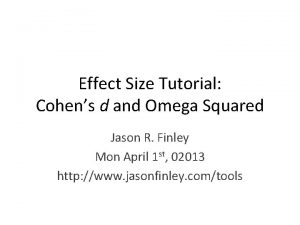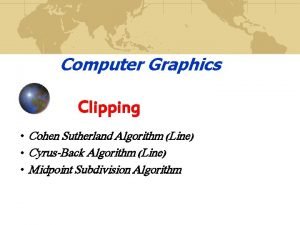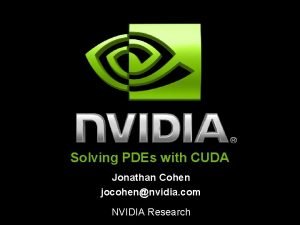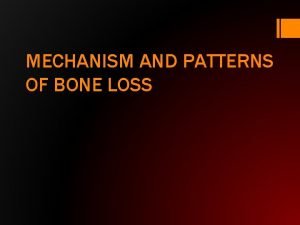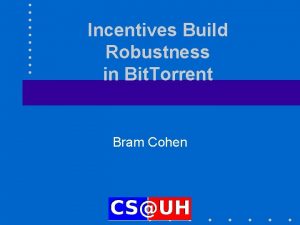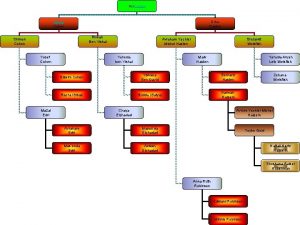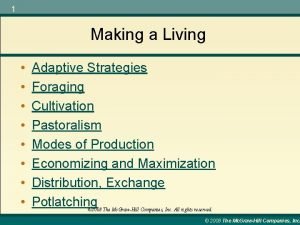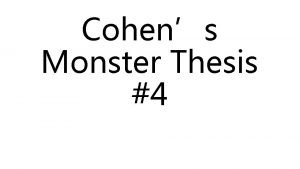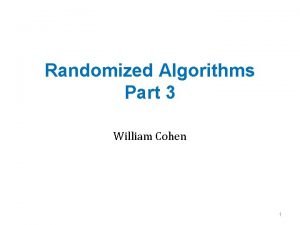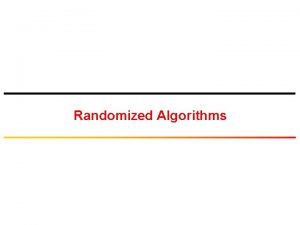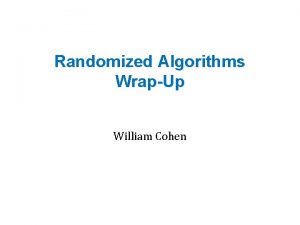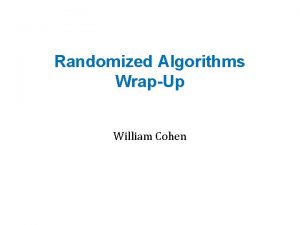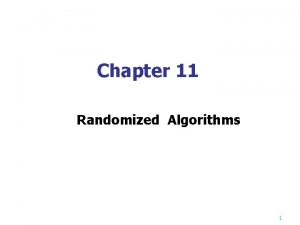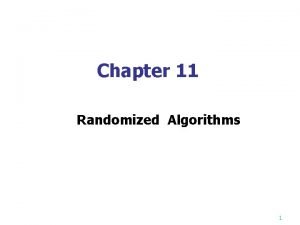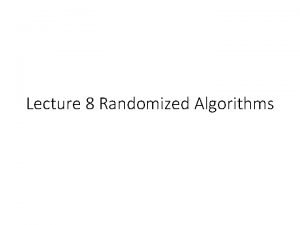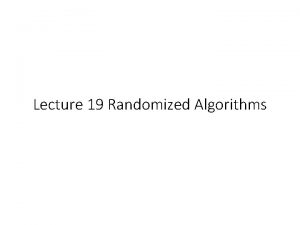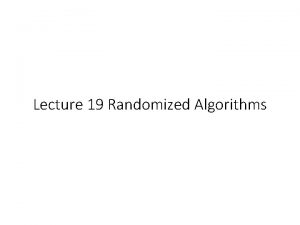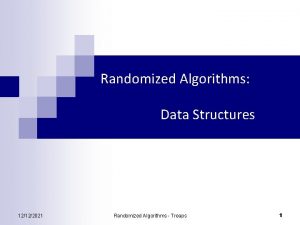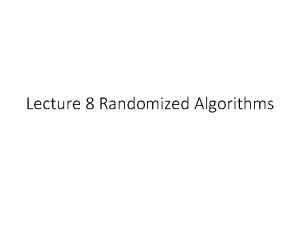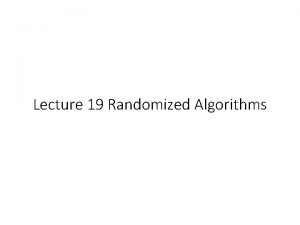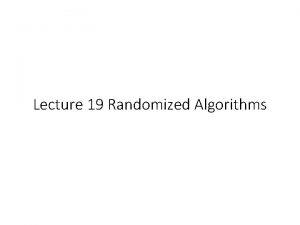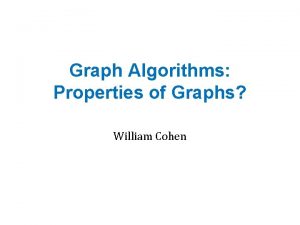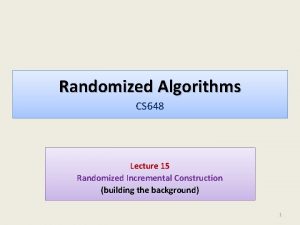Randomized Algorithms William Cohen Outline Randomized methods SGD











![Bloom filters • An implementation – Allocate M bits, bit[0]…, bit[1 -M] – Pick Bloom filters • An implementation – Allocate M bits, bit[0]…, bit[1 -M] – Pick](https://slidetodoc.com/presentation_image_h2/0053f4cb82219eb93a1bbf24559fed78/image-12.jpg)



























































- Slides: 71

Randomized Algorithms William Cohen

Outline • Randomized methods – SGD with the hash trick (review) – Other randomized algorithms • Bloom filters • Locality sensitive hashing

Learning as optimization for regularized logistic regression • Algorithm: • Initialize arrays W, A of size R and set k=0 • For each iteration t=1, …T – For each example (xi, yi) • Let V be hash table so that • pi = … ; k++ • For each hash value h: V[h]>0: » W[h] *= (1 - λ 2μ)k-A[j] » W[h] = W[h] + λ(yi - pi)V[h] » A[j] = k

Learning as optimization for regularized logistic regression • Initialize arrays W, A of size R and set k=0 • For each iteration t=1, …T – For each example (xi, yi) • k++; let V be a new array of size R; let tmp=0 • For each j: xi j >0: V[hash(j)%R] += xi j • Let ip=0 • For each h: V[h]>0: – W[h] *= (1 - λ 2μ)k-A[j] regularize W[h]’s – ip+= V[h]*W[h] – A[h] = k • p = 1/(1+exp(-ip)) • For each h: V[h]>0: – W[h] = W[h] + λ(yi - pi)V[h]

An example 2^26 entries = 1 Gb @ 8 bytes/weight

Results

A variant of feature hashing • Hash each feature multiple times with different hash functions • Now, each w has k chances to not collide with another useful w’ • An easy way to get multiple hash functions – Generate some random strings s 1, …, s. L – Let the k-th hash function for w be the ordinary hash of concatenation w sk

A variant of feature hashing a!=b 1 0 1 times 0 • Hash each feature. V(a) multiple with 1 1 2 0 0 1 0 V(a) 1 0 1 1 0 different hash functions V(b) 1 0 1 0 1 1 1 0 • Now, each w has k chances to not collide 1 1 0 0 with another useful w’ • An easy way to get multiple hash functions – Generate some random strings s 1, …, s. L – Let the k-th hash function for w be the ordinary hash of concatenation w sk

A variant of feature hashing • Why would this work? • Claim: with 100, 000 features and 100, 000 buckets: – k=1 Pr(any feature duplication) ≈1 – k=2 Pr(any feature duplication) ≈0. 4 – k=3 Pr(any feature duplication) ≈0. 01

Hash Trick - Insights • Save memory: don’t store hash keys • Allow collisions – even though it distorts your data some • Let the learner (downstream) take up the slack • Here’s another famous trick that exploits these insights….

Bloom filters • Interface to a Bloom filter – Bloom. Filter(int max. Size, double p); – void bf. add(String s); // insert s – bool bd. contains(String s); • // If s was added return true; • // else with probability at least 1 -p return false; • // else with probability at most p return true; – I. e. , a noisy “set” where you can test membership (and that’s it)
![Bloom filters An implementation Allocate M bits bit0 bit1 M Pick Bloom filters • An implementation – Allocate M bits, bit[0]…, bit[1 -M] – Pick](https://slidetodoc.com/presentation_image_h2/0053f4cb82219eb93a1bbf24559fed78/image-12.jpg)
Bloom filters • An implementation – Allocate M bits, bit[0]…, bit[1 -M] – Pick K hash functions hash(1, 2), hash(2, s), …. • E. g: hash(i, s) = hash(s+ random. String[i]) – To add string s: • For i=1 to k, set bit[hash(i, s)] = 1 – To check contains(s): • For i=1 to k, test bit[hash(i, s)] • Return “true” if they’re all set; otherwise, return “false” – We’ll discuss how to set M and K soon, but for now: • Let M = 1. 5*max. Size // less than two bits per item! • Let K = 2*log(1/p) // about right with this M

Bloom filters • Analysis (m bits, k hashers): – Assume hash(i, s) is a random function – Look at Pr(bit j is unset after n add’s): – … and Pr(collision): p= – …. fix m and n and minimize k: k=

Bloom filters • Analysis: – Plug optimal k=m/n*ln(2) back into Pr(collision): p= – Now we can fix any two of p, n, m and solve for the 3 rd: – E. g. , the value for m in terms of n and p:

Bloom filters • Interface to a Bloom filter – Bloom. Filter(int max. Size /* n */, double p); – void bf. add(String s); // insert s – bool bd. contains(String s); • // If s was added return true; • // else with probability at least 1 -p return false; • // else with probability at most p return true; – I. e. , a noisy “set” where you can test membership (and that’s it)

Bloom filters: demo

Bloom filters • An example application – Finding items in “sharded” data • Easy if you know the sharding rule • Harder if you don’t (like Google n-grams) • Simple idea: – Build a BF of the contents of each shard – To look for key, load in the BF’s one by one, and search only the shards that probably contain key – Analysis: you won’t miss anything, you might look in some extra shards – You’ll hit O(1) extra shards if you set p=1/#shards

Bloom filters • An example application – discarding singleton features from a classifier • Scan through data once and check each w: – if bf 1. contains(w): bf 2. add(w) – else bf 1. add(w) • Now: – bf 1. contains(w) w appears >= once – bf 2. contains(w) w appears >= 2 x • Then train, ignoring words not in bf 2

Bloom filters • An example application – discarding rare features from a classifier – seldom hurts much, can speed up experiments • Scan through data once and check each w: – if bf 1. contains(w): • if bf 2. contains(w): bf 3. add(w) • else bf 2. add(w) – else bf 1. add(w) • Now: – bf 2. contains(w) w appears >= 2 x – bf 3. contains(w) w appears >= 3 x • Then train, ignoring words not in bf 3








Locality Sensitive Hashing (LSH)

LSH: key ideas • Goal: – map feature vector x to bit vector bx – ensure that bx preserves “similarity”

Random Projections

Random projections u + ++ + - -- - - -u 2γ

Random projections To make those points “close” we need to project to a direction orthogonal to the line between them u + ++ + - -- - - -u 2γ

Random projections Any other direction will keep the distant points distant. u + ++ + - -- - So if I pick a random r and r. x’ are -u closer than γ then probably x and x’ were close to start with. 2γ

LSH: key ideas • Goal: – map feature vector x to bit vector bx – ensure that bx preserves “similarity” • Basic idea: use random projections of x – Repeat many times: • Pick a random hyperplane r • Compute the inner product of r with x • Record if x is “close to” r (r. x>=0) – the next bit in bx • Theory says that is x’ and x have small cosine distance then bx and bx’ will have small Hamming distance

LSH: key ideas • Naïve algorithm: – Initialization: • For i=1 to output. Bits: – For each feature f: » Draw r(f, i) ~ Normal(0, 1) – Given an instance x • For i=1 to output. Bits: LSH[i] = sum(x[f]*r[i, f] for f with non-zero weight in x) > 0 ? 1 : 0 • Return the bit-vector LSH – Problem: • the array of r’s is very large








LSH: “pooling” (van Durme) • Better algorithm: – Initialization: • Create a pool: – Pick a random seed s – For i=1 to pool. Size: » Draw pool[i] ~ Normal(0, 1) • For i=1 to output. Bits: – Devise a random hash function hash(i, f): » E. g. : hash(i, f) = hashcode(f) XOR random. Bit. String[i] – Given an instance x • For i=1 to output. Bits: LSH[i] = sum( x[f] * pool[hash(i, f) % pool. Size] for f in x) > 0 ? 1 : 0 • Return the bit-vector LSH


LSH: key ideas: pooling • Advantages: – with pooling, this is a compact re-encoding of the data • you don’t need to store the r’s, just the pool – leads to very fast nearest neighbor method • just look at other items with bx’=bx • also very fast nearest-neighbor methods for Hamming distance – similarly, leads to very fast clustering • cluster = all things with same bx vector

LSH: key ideas: online computation • Common task: distributional clustering – for a word w, x(w) is sparse vector of words that co-occur with w – cluster the w’s



GRAPH ALGORITHMS

Graph algorithms • Page. Rank implementations – in memory – streaming, node list in memory – streaming, no memory – map-reduce • A little like Naïve Bayes variants – data in memory – word counts in memory – stream-and-sort – map-reduce

Google’s Page. Rank web site xxx web site a b cdefg web site yyyy pdq. . web site a b cdefg web site yyyy Inlinks are “good” (recommendations) Inlinks from a “good” site are better than inlinks from a “bad” site but inlinks from sites with many outlinks are not as “good”. . . “Good” and “bad” are relative.

Google’s Page. Rank web site xxx • follows a random link, or web site a b cdefg web site yyyy pdq. . web site a b cdefg web site yyyy Imagine a “pagehopper” that always either • jumps to random page

Google’s Page. Rank (Brin & Page, http: //www-db. stanford. edu/~backrub/google. html) web site xxx • follows a random link, or web site a b cdefg web site yyyy pdq. . web site a b cdefg web site yyyy Imagine a “pagehopper” that always either • jumps to random page Page. Rank ranks pages by the amount of time the pagehopper spends on a page: • or, if there were many pagehoppers, Page. Rank is the expected “crowd size”

Page. Rank in Memory • Let u = (1/N, …, 1/N) – dimension = #nodes N • Let A = adjacency matrix: [aij=1 i links to j] • Let W = [wij = aij/outdegree(i)] – wij is probability of jump from i to j • Let v 0 = (1, 1, …. , 1) – or anything else you want • Repeat until converged: – Let vt+1 = cu + (1 -c)Wvt • c is probability of jumping “anywhere randomly”

Streaming Page. Rank • Assume we can store v but not W in memory • Repeat until converged: – Let vt+1 = cu + (1 -c)Wvt • Store A as a row matrix: each line is – i ji, 1, …, ji, d [the neighbors of i] • Store v’ and v in memory: v’ starts out as cu • For each line “i ji, 1, …, ji, d “ – For each j in ji, 1, …, ji, d Everything needed for update is right • v’[j] += (1 -c)v[i]/d there in row….

Streaming Page. Rank: with some long rows • Repeat until converged: – Let vt+1 = cu + (1 -c)Wvt • Store A as a list of edges: each line is: “i d(i) j” • Store v’ and v in memory: v’ starts out as cu • For each line “i d j“ • v’[j] += (1 -c)v[i]/d We need to get the degree of i and store it locally

Streaming Page. Rank: preprocessing • • Original encoding is edges (i, j) Mapper replaces i, j with i, 1 Reducer is a Sum. Reducer Result is pairs (i, d(i)) • Then: join this back with edges (i, j) • For each i, j pair: – send j as a message to node i in the degree table • messages always sorted after non-messages – the reducer for the degree table sees i, d(i) first • then j 1, j 2, …. • can output the key, value pairs with key=i, value=d(i), j

Preprocessing Control Flow: 1 I J I i 1 j 1, 1 i 1 i 1 j 1, 2 i 1 1 … … … i 1 j 1, k 1 i 2 I d(i) 1 i 1 d(i 1) i 1 1 . . … … i 2 d(i 2) i 1 1 … … j 2, 1 i 2 1 i 3 d)i 3) … … … … i 3 j 3, 1 i 3 1 … … … MAP I SORT REDUCE Summing values

Preprocessing Control Flow: 2 I J i 1 j 1, 1 i 1 j 1, 2 … … i 2 j 2, 1 … … I d(i) i 1 d(i 1) . . … i 2 d(i 2) … … MAP I J i 1 ~j 1, 1 i 1 ~j 1, 2 … … i 2 ~j 2, 1 … … I I I i 1 d(i 1) j 1, 1 i 1 ~j 1, 1 i 1 d(i 1) j 1, 2 i 1 ~j 1, 2 … … … . . … i 1 d(i 1) j 1, n 1 i 2 d(i 2) j 2, 1 d(i) i 2 ~j 2, 1 … … … i 1 d(i 1) i 2 ~j 2, 2 i 3 d(i 3) j 3, 1 . . … … … i 2 d(i 2) … … SORT copy or convert to messages REDUCE join degree with edges

Streaming Page. Rank: with some long rows • Repeat until converged: – Let vt+1 = cu + (1 -c)Wvt • Pure streaming: use a table mapping nodes to degree+page. Rank – Lines are i: degree=d, pr=v • For each edge i, j – Send to i (in degree/pagerank) table: outlink j • For each line i: degree=d, pr=v: – send to i: increment. VBy c – for each message “outlink j”: • send to j: increment. VBy (1 -c)*v/d • For each line i: degree=d, pr=v – sum up the increment. VBy messages to compute v’ – output new row: i: degree=d, pr=v’ One identity mapper with two inputs (edges, degree/ pr table) Reducer outputs the increment. VBy messages Two-input mapper + reducer

Control Flow: Streaming PR I J I d/v to delta I delta i 1 j 1, 1 i 1 d(i 1), v(i 1) i 1 c i 1 j 1, 2 i 1 ~j 1, 1 (1 -c)v(i 1)/d(i 1) i 1 (1 -c)v(…)…. … … i 1 ~j 1, 2 … … i 1 (1 -c)… i 2 j 2, 1 . . j 1, n 1 i . . … … i 2 d(i 2), v(i 2) i 2 c i 2 ~j 2, 1 … i 2 (1 -c)… i 2 ~j 2, 2 … … i 2 …. … … i 3 c … … I d/v i 1 d(i 1), v(i 1) i 2 d(i 2), v(i 2) … … REDUCE MAP SORT copy or convert to messages send “page. Rank updates ” to outlinks MAP SORT

Control Flow: Streaming PR to delta I delta i 1 c I v’ j 1, 1 (1 -c)v(i 1)/d(i 1) i 1 (1 -c)v(…)…. i 1 ~v’(i 1) I … … i 1 (1 -c)… i 2 ~v’(i 2) i 1 d(i 1), v’(i 1) j 1, n 1 i . . … … i 2 d(i 2), v’(i 2) i 2 c j 2, 1 … i 2 (1 -c)… … … i 2 …. i 3 c … … … d/v … … I d/v i 1 d(i 1), v(i 1) i 2 d(i 2), v(i 2) … … REDUCE MAP SORT REDUCE MAP Summing values SORT REDUCE Replace v with v’

Control Flow: Streaming PR I J i 1 j 1, 1 i 1 j 1, 2 … … i 2 j 2, 1 … … I d/v i 1 d(i 1), v(i 1) i 2 d(i 2), v(i 2) … … MAP copy or convert to messages and back around for next iteration….

More on graph algorithms • Page. Rank is a one simple example of a graph algorithm – but an important one – personalized Page. Rank (aka “random walk with restart”) is an important operation in machine learning/data analysis settings • Page. Rank is typical in some ways – Trivial when graph fits in memory – Easy when node weights fit in memory – More complex to do with constant memory – A major expense is scanning through the graph many times • … same as with SGD/Logistic regression • disk-based streaming is much more expensive than memory-based approaches • Locality of access is very important! • gains if you can pre-cluster the graph even approximately • avoid sending messages across the network – keep them local

Machine Learning in Graphs - 2010

Some ideas • Combiners are helpful – Store outgoing increment. VBy messages and aggregate them – This is great for high indegree pages • Hadoop’s combiners are suboptimal – Messages get emitted before being combined – Hadoop makes weak guarantees about combiner usage


I’d think you want to spill the hash table to memory when it gets large

Some ideas • Most hyperlinks are within a domain – If we keep domains on the same machine this will mean more messages are local – To do this, build a custom partitioner that knows about the domain of each node. Id and keeps nodes on the same domain together – Assign node id’s so that nodes in the same domain are together – partition node ids by range – Change Hadoop’s Partitioner for this

Some ideas • Repeatedly shuffling the graph is expensive – We should separate the messages about the graph structure (fixed over time) from messages about page. Rank weights (variable) – compute and distribute the edges once – read them in incrementally in the reducer • not easy to do in Hadoop! – call this the “Schimmy” pattern

Schimmy Relies on fact that keys are sorted, and sorts the graph input the same way…. .

Schimmy
 Sgd vs gd
Sgd vs gd Sgd vs bgd
Sgd vs bgd Sgd
Sgd Bram cohen jenna cohen
Bram cohen jenna cohen Types of randomized algorithms
Types of randomized algorithms Randomized algorithms and probabilistic analysis
Randomized algorithms and probabilistic analysis William cohen norman
William cohen norman Levenshtein
Levenshtein William w. cohen
William w. cohen Indirect methods of contoring uses how many methods
Indirect methods of contoring uses how many methods Business research methods by zikmund
Business research methods by zikmund The quote sandwich example
The quote sandwich example Randomized polynomial time
Randomized polynomial time Completely randomized design
Completely randomized design Randomized skip list
Randomized skip list Switching replications design
Switching replications design Duncan's multiple range test
Duncan's multiple range test Randomised block design
Randomised block design Difference between rbd and rcbd
Difference between rbd and rcbd Randomized block design adalah
Randomized block design adalah Define completely randomized design
Define completely randomized design Randomized hill climbing
Randomized hill climbing Matched-pair design
Matched-pair design Expected running time
Expected running time Completely randomized design
Completely randomized design Randomized hill climbing
Randomized hill climbing Rcbd meaning in research
Rcbd meaning in research Statistical model for crd
Statistical model for crd Factorial randomized block design
Factorial randomized block design Randomized polynomial time
Randomized polynomial time Advantage of randomized controlled trial
Advantage of randomized controlled trial How to pronounce nivolumab
How to pronounce nivolumab Randomized algorithm in daa
Randomized algorithm in daa Anova table
Anova table N = z2pq/d2
N = z2pq/d2 Effect size
Effect size Cohen's d effect size criteria
Cohen's d effect size criteria Cohen manion and morrison 2018
Cohen manion and morrison 2018 Taya cohen
Taya cohen Cohen's d formula
Cohen's d formula Alan cohen neurosurgery
Alan cohen neurosurgery Harold cohen aaron
Harold cohen aaron Cohen's f
Cohen's f Roscoe (1975)
Roscoe (1975) Etan neliö
Etan neliö Leonard cohen biografia
Leonard cohen biografia Cohen kappa formula
Cohen kappa formula Eliahu cohen
Eliahu cohen Cohen's d interpretation
Cohen's d interpretation Leonard cohen monastery
Leonard cohen monastery Austin and aiden cohen
Austin and aiden cohen Cohens effect size
Cohens effect size Midpoint subdivision algorithm
Midpoint subdivision algorithm Contoh soal clipping cohen sutherland
Contoh soal clipping cohen sutherland Cohen's d interpretation
Cohen's d interpretation Cohen's d table
Cohen's d table Cohen d interpretation
Cohen d interpretation Jonathan cohen nvidia
Jonathan cohen nvidia Ordinale skala
Ordinale skala David cohen swarthmore
David cohen swarthmore Wall hemiseptal
Wall hemiseptal Leonard norman cohen
Leonard norman cohen La decision de anne torrent
La decision de anne torrent Ben cohen deaf
Ben cohen deaf Cliping adalah
Cliping adalah Brotchin
Brotchin Potlaching
Potlaching Man-made monsters daniel cohen pdf
Man-made monsters daniel cohen pdf Christina cohen caltech
Christina cohen caltech Cohen monster theses
Cohen monster theses David cohen swarthmore
David cohen swarthmore Katrina cohen-palacios
Katrina cohen-palacios



